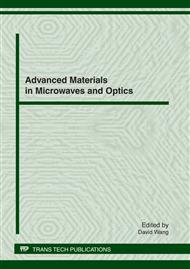[1]
A.G. Dekker and T. J. Malthus, First derivative indices for the remote sensing of inland water quality using high spectral resolution reflectance, Environment International, vol. 21 (2), 1995, pp.221-232.
DOI: 10.1016/0160-4120(95)00012-7
Google Scholar
[2]
G. L. Clark, C. Ewing and C. J. Lorenzen, Spectra of back-scattered light from the sea obtained from aircraft as a measure of chlorophyll concentration, Science, vol. 167, 1970 pp.1119-1121.
DOI: 10.1126/science.167.3921.1119
Google Scholar
[3]
C. Mobley, A numerical model for computation of radiance distributions in natural waters with wind roughened surfaces, Limnology and Oceanography, vol. 34 (8), 1989, pp.1473-1283.
DOI: 10.4319/lo.1989.34.8.1473
Google Scholar
[4]
A. Voutilainen, T. Pyhalahti, K. Y. Kallio, J. Pulliainen, H. Haario and J. P. Kaipio, A filtering approach for estimating lake water quality from remote sensing data, International Journal of Applied Earth Observation and Geoinformation, vol. 9, July 2006, p.50.
DOI: 10.1016/j.jag.2006.07.001
Google Scholar
[5]
H. R. Gordon and A. Morel, Remote Assessment of Ocean Color for Interpretation of Satellite Visible Imagery: A Review, Springer-Verlag, New York, (1983).
Google Scholar
[6]
R. M. Pope and E. S. Fry, Absorption spectrum (380-700 nm) of pure water. II. Integrating cavity measurements, Appl. Opt., vol. 36, 1997, pp.8710-8723.
DOI: 10.1364/ao.36.008710
Google Scholar
[7]
A. Tanaka, M. Kishino, R. Doerffer, H. Schiller, T. Oishi and T. Kubota, Development of a neural network algorithm for retrieving conventrations of chlorophyll, suspended matter and yellow substance from radiance data of the ocean color and temperature scanner, J. Oceanogr., vol. 60, 2004, p.519.
DOI: 10.1023/b:joce.0000038345.99050.c0
Google Scholar
[8]
H. Hakvoort, J. de Haan, R. Jordans, R. Vos, S. Peters and M. Rijkeboer, Towards airborne remote sensing of water quality in The Netherlands—validation and error analysis, ISPRS Journal of Photogrammetry & Remote Sensing, vol. 57, July 2002, p.171.
DOI: 10.1016/s0924-2716(02)00120-x
Google Scholar
[9]
P. Ammenberg, P. Flink, T. Lindell, D. Pierson and N. Strombeck, Bio-optical modelling combined with remote sensing to assess water quality, International Journal Remote Sensing, vol. 23, 2002, p.1621–1638.
DOI: 10.1080/01431160110071860
Google Scholar
[10]
J. E. Tyler and R. C. Smith, Spectro-radiometric characteristics of natural light under water, Journal of the Optical Society of America, vol. 57(5), 1967, pp.595-601.
Google Scholar
[11]
G. Oron and A. Gitelson, Real-time quality monitoring by remote sensing of contaminated water-bodies: waste stabilization pond effluent, Water Resourses, vol. 30 (12), 1996, pp.3106-3114.
DOI: 10.1016/s0043-1354(96)00203-5
Google Scholar
[12]
A. G. Dekker, H. J. Hoogenboom, L. M. Goddijn and T. J. Malthus, The relation between inherent optical properties and reflectance spectra in turbid inland waters, Remote Sensing Reviews, vol. 15, 1997, pp.59-74.
DOI: 10.1080/02757259709532331
Google Scholar
[13]
H. Chuanmin, A simple instrument for measurement of remote sensing reflectance in coastal environment, Institute for Marine Remote Sensing (IMaRS), College of Marine Science (CMS), University of South Florida, 140 7th Ave. S., St. Petersburg, FL 33701, USA, Proc. of SPIE, vol. 4897 (42), (2002).
Google Scholar
[14]
H. R. Gordon and K. Ding, Self shading of in-water optical instruments, Limnology Oceanography, vol. 37(3), 1992, pp.491-500.
DOI: 10.4319/lo.1992.37.3.0491
Google Scholar
[15]
S. Hooker and S. Maritorena, An Evaluation of Oceanographic Radiometers and Deployment Methodologies, Journal of Atmospheric and Oceanic Technology, American Meteorological Society, vol. 17, 2002, pp.811-830.
DOI: 10.1175/1520-0426(2000)017<0811:aeoora>2.0.co;2
Google Scholar
[16]
C. Hu and K. L. Carder, Atmospheric correction of airborne sensors: comment on a scheme used for CASE, Remote Sens. Environ., vol. 79, 2002, pp.134-137.
DOI: 10.1016/s0034-4257(01)00232-2
Google Scholar
[17]
H. Hakvoort, J. de Haan, R. Jordans, R. Vos, S. Peters and M. Rijkeboer, Towards airborne remote sensing of water quality in The Netherlands—validation and error analysis, ISPRS Journal of Photogrammetry & Remote Sensing, vol. 57, July 2002, p.171.
DOI: 10.1016/s0924-2716(02)00120-x
Google Scholar
[18]
H. R. Gordon, O. B. Brown and M. M. Jacobs, Computed relationships between the inherent and apparent optical properties of a flat homogeneous ocean, Appl. Opt., vol. 14 (2), 1975, p.417– 427.
DOI: 10.1364/ao.14.000417
Google Scholar
[19]
D. G. Hadjimitsis, M. G. Hadjimitsis, K. Themistocleous and A. Agapiou, Integration of micro-sensor technology and remote sensing for monitoring coastal water quality in a municipal beach and other areas in Cyprus, Proc. of SPIE, vol. 7472 74720P-1, 2009, doi: 10. 1117/12. 830582.
DOI: 10.1117/12.830582
Google Scholar
[20]
D. G. Hadjimitsis, M. G. Hadjimitsis, L. Toulios and C. Clayton, Use of space technology for assisting water quality assessment and monitoring of inland water bodies, Physics and Chemistry of the Earth, vol. 35, 2010, p.115–120.
DOI: 10.1016/j.pce.2010.03.033
Google Scholar
[21]
D. G. Hadjimitsis, M. G. Hadjimitsis, C. R. I. Clayton, and B. Clarke, Monitoring turbidity in Kourris Dam in Cyprus utilizing Landsat TM remotely sensed data, Water Resources Management: An International Journal, vol. 20 (3), 2006, p.449–465.
DOI: 10.1007/s11269-006-3089-y
Google Scholar


